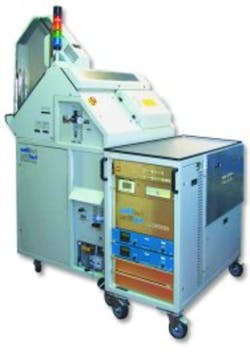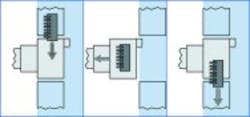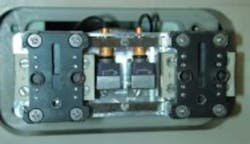Not so long ago, experts were unsure if micro-electromechanical systems (MEMS) would become more than a laboratory curiosity. But the latest market projections show a growth in the MEMS market by a factor of two each year.
By all predictions, MEMS will become a several billion-dollar semiconductor market in the near future.
As a result, nearly every large semiconductor manufacturer has its own MEMS production line, facing constantly rising production volumes. As production techniques stabilize and the number of MEMS increases, the industry faces another challenge: the devices must be adequately tested.
The need for reliable tests has been mandated by the automotive industry, driven by the relatively high risk of injuries to humans if air-bag or antilock braking system sensors fail. These components must be stimulated during the execution of the electrical test.
Standard test handlers only expose the device under test to high or low temperatures. They cannot expose it to additional stimuli such as magnetic fields, required for Hall sensors, or acceleration to test acceleration sensors. To date, no common solution is available to solve these problems in high-volume production.
Based on the necessity to test these parameters, most MEMS manufacturers started to develop their own equipment with the know-how available from institutes, universities, or government offices. Sometimes, these machines were extremely large, but they worked quite well for small lots.
As the number of devices increases exponentially, more and more suppliers are recognizing the need for a testing and handling solution that is more suitable for the needs of high-volume production lines. The main points to be considered are throughput (index time), reliability, floor space, test-floor requirements, equipment maintenance, test precision, and costs.
MEMS must be tested while operating, with the necessary stimulation provided by the handling system. A specialized test platform can provide the stimuli for MEMS tests while docking to a standard IC handler, as shown in Figure 1. In this way, the test processes and hardware already in use by a semiconductor manufacturer can remain largely unchanged. Only an additional MEMS test unit is required.
The idea of developing a platform solution has attracted the attention of the Fraunhofer Institute of Microintegration in Germany. The European government will provide funding for development of a test platform by the institute and another MEMS manufacturer.
Such a test unit stimulates the device under test; that is, it accelerates it in the required direction with the necessary power and amplitude. Ideally, this shaker module can be configured with different acceleration units, depending on the required direction of acceleration (X, Y, Z, or rotational movement).
The shaker module sits between the testhead and the handler so that, from one side, the device is picked up from the handler and contacted. The testhead is connected on the other side of the module to measure the test parameters under operating conditions. Because the shaker module and the handler are separate units, they are mechanically decoupled, and the vibration of the acceleration test does not influence the handler.
The shaker module provides verification that the devices meet their specifications. This is necessary because, for example, acceleration sensors are used in air bags where the safety requirements necessitate very detailed and precise tests.
For testing, the handler places a device in the shaker test nest, where it is contacted. The connection cables to the testhead are shielded to minimize electrical degradation of the test signal. During test, the shaker arm is disconnected from the handler. This ensures that the test results will not be affected by handler vibration.
Each nest includes an acceleration sensor constantly monitoring and controlling the movement. After testing, the shaker arm places the devices back into the handler for sorting. The three-step process is shown in Figure 2.
A high-precision shaker agitates the contact heads. The actuator module is mounted on shock-absorbent wheels to minimize external influences. It is easy to replace, allowing quick exchange and conversion of the actuator module to perform different head-movement directions.
Only minor modifications are necessary to dock the shaker module to the handler. As a result, it is possible to retrofit existing systems with the shaker module.
For the testhead, the shaker module provides a flat, vertical contact site for easy docking, making it suitable for use with most testheads. The shaker shown in Figure 3 has two shaker nests for two devices each. As a result, four devices can be tested in parallel if a quad handler is used. It also is possible to install two different actuator units in one shaker.
Rising demands for device traceability highlight the relevance of a dot-matrix code reader, which can be used with the shaker modules to identify each device. It also may be beneficial to use cameras to scan a dot-matrix code on the device. The code identifies each device and allows correlation of test data after sorting. The plungers with the cameras do not limit the temperature performance of the system, and they have no influence on the performance of the shaker.
With the growing MEMS market, the need for test setups also has increased. In response to this need, Multitest, in cooperation with a large acceleration sensors manufacturer, has developed a standard platform solution for acceleration sensor testing. The platform already is used by semiconductor manufacturers and, in the future, will expand to address new applications such as testing optical, pressure, and other types of MEMS.
About the Author
Ralf Jaeckel is the product manager at Multitest responsible for the MEMS product line. Multitest, Äussere Oberaustrasse 4, D-83026 Rosenheim, Germany, 011 49 8031 4060, e-mail: [email protected]
Return to EE Home Page
Published by EE-Evaluation Engineering
All contents © 2002 Nelson Publishing Inc.
No reprint, distribution, or reuse in any medium is permitted
without the express written consent of the publisher.
May 2002



